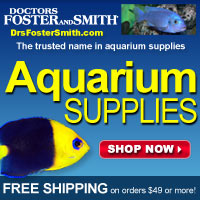Proper Fish Quarantine Procedures by Peter Ponzio(AGA)
Most people who keep koi are familiar with aeromonas and KHV, and have instituted proper fish quarantine procedures to ensure the safety of their existing fish stocks and new purchases. Unfortunately, it took an outbreak of KHV for folks to begin practicing safe fish introduction procedures.
The goldfish hobby has not experienced an outbreak of KHV, but aeromonas continues to represent a potential threat to fish health. The same precautions that apply to the quarantine of koi should apply to goldfish, as well. Most knowledgeable sources recommend that new fish be isolated from existing stocks for a period of one month, at a minimum. This requires a separate fish holding tank(s), as well as separate biological filtration for the holding tank. Usually, it is not advisable to medicate new fish, although some folks prefer a dip in a salt solution, and small amounts of salt(approximately 2 – 3 parts per thousand) to be added to the holding tank. For a simple method to determine the proper dosing for a tank or pond, please visit the Midwest Pond and Koi Society website at MPKS, and consult Bob Passovoy’s article, which explains the relationship between container size and pounds of salt to be added. If, after having the fish for awhile, disease symptoms occur, you should treat the fish with the appropriate medications. IN some instances, it might be advisable to contact a vet specializing in fish, to help with a diagnosis. I personally isolate my fish from 1 – 3 months, depending on the available room that I have at any given point in time, and the general health and appearance of the fish.
If you suspect that a fish that you purchased from a dealer has a disease, it is worth your while to contact the dealer to see if anyone else has reported a problem with their fish. The dealer may be aware of problems that other people are facing with their fish, and may be able to offer assistance. In some cases, dealers may be unaware of problems, and discussing your concern with your dealer in a calm, helpful fashion is always preferable to starting an argument. Fish can, and do, get sick despite the best efforts of the dealer to maintain a healthy environment while the fish is in their care.
Some people purchase fish from a dealer, and immediately enter them in a fish show. While this may produce immediate results in the form of a trophy, in most cases, it is harmful to the long-term health of the fish, especially if the dealer receives the fish from an overseas locations, and trans-ships them to the show site without an intervening “break-in” period. Unfortunately, this type of thing happens on a fairly regular basis, in most cases, because folks expect it from a breeder. If you’re really concerned about the long-term health of the fish, buy the first s few months before a show, and give it a chance to acclimate in its new environment before subjecting the fish to the stress of a fish show.
Since most shows occur in the summer or fall, the spring is an ideal time to purchase new fish at a spring trade show, allow the fish to acclimate, and then show the fish at one of the fish shows later in the year. This practice allows the fish owner to quarantine and acclimate the fish, and decide if the fish is ready for the rigors of a fish show.
Good quarantine procedures are good for the hobby, breeders, and fish enthusiast. They allow the fish to acclimate at their own rate, and improve the chances of fish not only surviving, but thriving in their new environment.
Click here for discussion regarding proper quarantine procedures.






